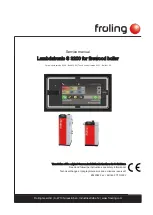
Green Heating Technology
33
•
If the
CO
2
value is
HIGHER
than allowed, turn the screw R.Q. ADJ.
CLOCKwise
;
•
If the
CO
2
value is
LOWER
than al
-
lowed, turn the screw R.Q. ADJ.
COUN-
TERCLOCKwise
;
Remark:
if you have adjusted the CO
2
at
the nominal input, we advise you to
check again the CO
2
and the off-set at
the reduced input (steps
3
to
7
).
IMPORTANT: at the end of the check
or the adjustments, it is INDISPEN-
SABLE:
•
close, on the gas valve, the pressure
plug
PINT
by turning the specific screw;
• close the flue plugs used, by restoring
the tapping insert
2
and the screw
1
,
caring that the plastic surface of the
flange is not damaged or worn;
•
seal the screw cover of P.R. ADJ. and
the screw R.Q. ADJ. if they have been
used;
• check the correct flue system tightness,
especially the tightness of the tapping
insert
2
.
Max heating power adjust
-
ment
The maximum heating power output must be
set in accordance with the system require
-
ments (stated in the project). Power input
values, corresponding fan rpms and relevant
display indications are listed in the "Power
input / display / fan rpm table" on page 34.
The adjustment will be performed through the boiler’s controls, following a special procedure that
avoids accidental activations by the User:
1.
get information about the maximum heating power requirement of the heating system (reported
on the project documentation of the system itself);
2. supply the boiler and turn the Summer/Winter knob
to Summer position
;
3.
ensure that there are NOT domestic hot water requests (no open taps); if the room thermostat is
installed, make so that it requires the heating (e.g. raise the requested room temperature manu-
ally);
•
turn the Hot Water knob
on
service
position: on the display will appear a flashing number
from 00 to 99 that indicates the current set point of the value of heating power, where the value
00
corresponds to the minimum setting of the gas valve
and the value
99
corresponds to the
maximum;
















































